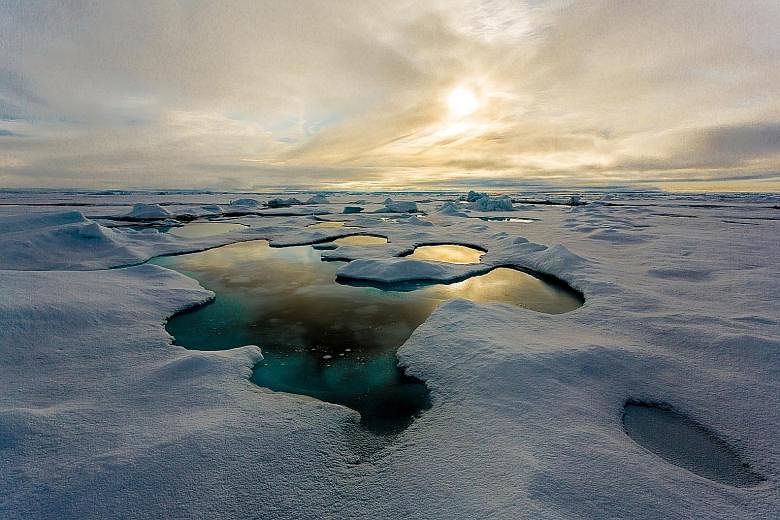PARIS • Researchers have warned of a troubling accumulation of microplastics in sea ice floating in the Arctic Ocean, a major potential source of water pollution as global warming melts the frozen water.
A team from the Alfred Wegener Institute for Polar and Marine Research found 17 different plastic types in ice samples gathered during three Arctic expeditions on board the research icebreaker Polarstern in 2014 and 2015.
They included plastic from shopping bags and food packaging, from ship paint, fishing nets, nylon and polyester found in synthetic fabrics, and cigarette filters.
One sample contained the highest concentration of microplastics ever found in sea ice - up to 12,000 particles per litre of frozen water.
This was two to three times higher than any past measurement, the researchers wrote in the journal Nature Communications.
The discovery suggests that microplastics "are now ubiquitous within the surface waters of the world's ocean", sea ice physicist Jeremy Wilkinson of the British Antarctic Survey said in a comment on the study. "Nowhere is immune," he said via the Science Media Centre in London.
Sea ice grows from the freezing of sea water directly underneath the existing ice, thus incorporating floating microplastics as it grows downwards, he said. This means the plastics were present as the ice was growing, and drifting, in the Arctic Ocean. Of particular concern was the particles' small size.
Some were only 11 micrometres across - about a sixth the diameter of a human hair, the team said. A micrometre is a millionth of a metre.
This "means they could easily be ingested by Arctic micro-organisms" such as small crustaceans on which fish feed, said study co-author Ilka Peeken, a biologist from the Alfred Wegener Institute for Polar and Marine Research.
"No one can say for certain how harmful these tiny plastic particles are for marine life, or ultimately also for human beings," she said.
Microplastics are less than 5mm long, about the size of a sesame seed. They come in the form of "microbeads" used in face scrubs and toothpaste, or are created when larger pieces are degraded by the sun, temperature changes, or mechanic abrasion.
The contribution of microplastics to the headache of ocean pollution is unclear.
According to environmental group World Wide Fund for Nature, 8.8 million tonnes of plastic enters the oceans every year, equivalent to a garbage truck dumping a full load every minute.
On current trends, there will be more plastic than fish in the sea by 2050, the United Nations warns.
For the study, Dr Peeken and a team used a spectrometer to bombard the ice cores with infrared light. They analysed the radiation reflected by the plastic pieces to determine their likely origins.
Samples from the Canada Basin, fed by water from the north-east Pacific via the Bering Strait, were high in polyethylene used in packaging material, leading the authors to conclude that these particles came mainly from the so-called Great Pacific Garbage Patch - a swirling plastic dump in the ocean now bigger than France, Germany and Spain combined.
Others were rich in particles from paint and varnish used on ships, while nylon bits from fish nets were "found frequently in almost all sea ice cores".
The sea ice binds the particles for between two and 11 years, the researchers said. What happens to the sea ice then, is unclear - do the particles remain in the Arctic, are they transported to waters farther south, or do they sink?
Other studies have recently warned that humans are ingesting microplastics in shellfish, tap water and bottled water.
The health risks remain unclear.
AGENCE FRANCE-PRESSE

